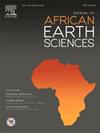Tütün Tepeleri(Baskil-Elazig/土耳其)铁-氧化物-铜-金(IOCG)矿化的形成条件和地球化学特征
IF 2.2
4区 地球科学
Q2 GEOSCIENCES, MULTIDISCIPLINARY
引用次数: 0
摘要
Tütün Tepeleri 铁-氧-铜-金(IOCG)矿化位于东陶勒斯山脉(土耳其巴斯基尔-埃拉泽),与被晚白垩世 Bilaser Tepe 岩浆岩(四分闪长岩、花岗闪长岩、花岗闪长岩、辉长岩斑岩、单斜闪长岩、单长岩、辉绿岩和闪长岩斑岩)切割的 Baskil 岩浆岩(闪长岩、辉长岩和辉绿岩)有关。巴斯基尔岩浆岩属于康尼阿世-山东安世(82-86 Ma),具有钙碱性和 I 型。Bilaser Tepe Magmatics 属康庞纪(73-74 Ma),代表大洋弧与金牛座地台碰撞后的延伸环境。本研究首次确定了 Tütün Tepeleri 地区的钠钙质蚀变带,该蚀变带被不同的研究人员确定为斑岩型矿化,并从铁-氧化物-铜-金(IOCG)矿床的角度对矿化进行了评估。该地区已发现三种蚀变带,包括钠钙质蚀变带。它们分别是钠钙质蚀变带(透闪石-阳起石、白云石、绿泥石、磁铁矿)、钾长石蚀变带(黑云母、石英、绿泥石、K 长石、无水石膏)和绢云母蚀变带(绢云母、碳酸盐、石英、绿泥石、伊利石)。钠钙质蚀变在该地区的分布范围超过 1 平方公里,厚度达 500 米,偶尔会被钾盐蚀变覆盖,就像世界上类似的铁-氧化物-铜-金(IOCG)矿床一样。Tütün Tepeleri 的矿化物是稀有的磁铁矿脉,在闪长岩中发育的钠钙质蚀变中具有强烈的磁铁矿分散性。矿物成因形式为磁铁矿、辉钼矿、黄铁矿、砷黄铁矿、黄铜矿、闪锌矿、方铅矿、赤铁矿、孔雀石和天青石,磁铁矿中的钛含量被测定为 0.13-0.64%。铁含量平均为 20.13%。在含矿石英脉中测量到的流体包裹体的形成温度平均为 320.3 °C,盐度平均为 11.32% 的 NaCl 当量。这些矿化物的同位素分析结果显示,δ34Spyrite = 6-8.9;δ34Sc.pyrite = 3.8-5.5;δ18Oquartz 的测定范围为 10.8-13.2 和 δD = (-37) - (-53)。根据同位素分析结果确定的蚀变类型表明矿化发生在岩浆-热液系统中,再结合磁铁矿中较低的钛含量、形成温度和盐度值进行评估,预计 Tütün Tepeleri 矿化是在热液-岩浆系统中形成的铁-氧化物-铜-金 (IOCG) 矿床的一个实例。本文章由计算机程序翻译,如有差异,请以英文原文为准。
Formation conditions and geochemistry of the Tütün Tepeleri (Baskil-Elazig/Türkiye) Fe-oxide-Cu-Au (IOCG) mineralization
The Tütün Tepeleri Fe-Oxide-Cu-Au (IOCG) mineralization is located in the Eastern Taurus Mountains (Baskil-Elazığ/Turkey) and it is associated with Baskil magmatites (diorite, gabbro and tonalite) cut by Late Cretaceous Bilaser Tepe magmatites (quartized diorite, granite, granodiorite, tonalite porphyry, monzosyenite, monzonite, aplite and diorite porphyry). Baskil Magmatites are Coniacian-Santonian (82–86 Ma), calc-alkaline in character and I-type. Bilaser Tepe Magmatics are Campanian (73–74 Ma) and represent an extensional environment after the collision of oceanic arc and the Taurus platform. In this study, the Sodic-calcic alteration zone in the Tütün Tepeleri region, which was determined as Porphyry type mineralization by different researchers, was determined for the first time and the mineralizations were evaluated in terms of Fe-Oxide-Cu-Au (IOCG) deposits. Three types of alteration zones have been identified in the region, including the sodic-calcic alteration zone. These are sodic-calcic (tremolite-actinolite, albite, epidote, chlorite, magnetite), potassic (biotite, quartz, chlorite, K-feldspar, anhydrite) and sericitic (sericite, carbonate, quartz, chlorite, illite) alterations. Sodic-calcic alteration is more widespread in the region than >1 km2, reaches thicknesses of 500 m, and is occasionally overlain by potassic alterations, just like similar Fe-Oxide-Cu-Au (IOCG) deposits in the world. Tütün Tepeleri mineralizations are in the form of rare magnetite veins with intense magnetite dispersion within the sodic-calcic alteration developed in diorites. Mineral paragenesis is in the form of magnetite, molybdenite, pyrite, arsenopyrite, chalcopyrite, sphalerite, galena, hematite, malachite and azurite, and Ti content in magnetites is determined as 0.13–0.64%. Fe content is 20.13% on average. Formation temperatures in fluid inclusions measured in ore-bearing quartz veins are 320.3 °C on average and salinity is 11.32% NaCl equivalent on average. Isotope analysis results of these mineralizations show δ34Spyrite = 6–8.9; δ34Sc.pyrite = 3.8–5.5; δ18Oquartz was determined in the range of 10.8–13.2 and δD = (−37) – (−53). When the alteration types determined with isotope analysis results showing that the mineralization occurred in a magmatic-hydrothermal system, the low Ti content in the magnetites, the formation temperature and salinity values are evaluated together, it was anticipated that Tütün Tepeleri mineralization is an example of Fe-Oxide-Cu-Au (IOCG) deposits formed in a hydrothermal-magmatic system.
求助全文
通过发布文献求助,成功后即可免费获取论文全文。
去求助
来源期刊

Journal of African Earth Sciences
地学-地球科学综合
CiteScore
4.70
自引率
4.30%
发文量
240
审稿时长
12 months
期刊介绍:
The Journal of African Earth Sciences sees itself as the prime geological journal for all aspects of the Earth Sciences about the African plate. Papers dealing with peripheral areas are welcome if they demonstrate a tight link with Africa.
The Journal publishes high quality, peer-reviewed scientific papers. It is devoted primarily to research papers but short communications relating to new developments of broad interest, reviews and book reviews will also be considered. Papers must have international appeal and should present work of more regional than local significance and dealing with well identified and justified scientific questions. Specialised technical papers, analytical or exploration reports must be avoided. Papers on applied geology should preferably be linked to such core disciplines and must be addressed to a more general geoscientific audience.
 求助内容:
求助内容: 应助结果提醒方式:
应助结果提醒方式:


